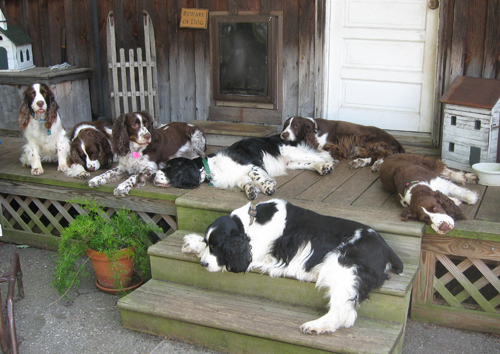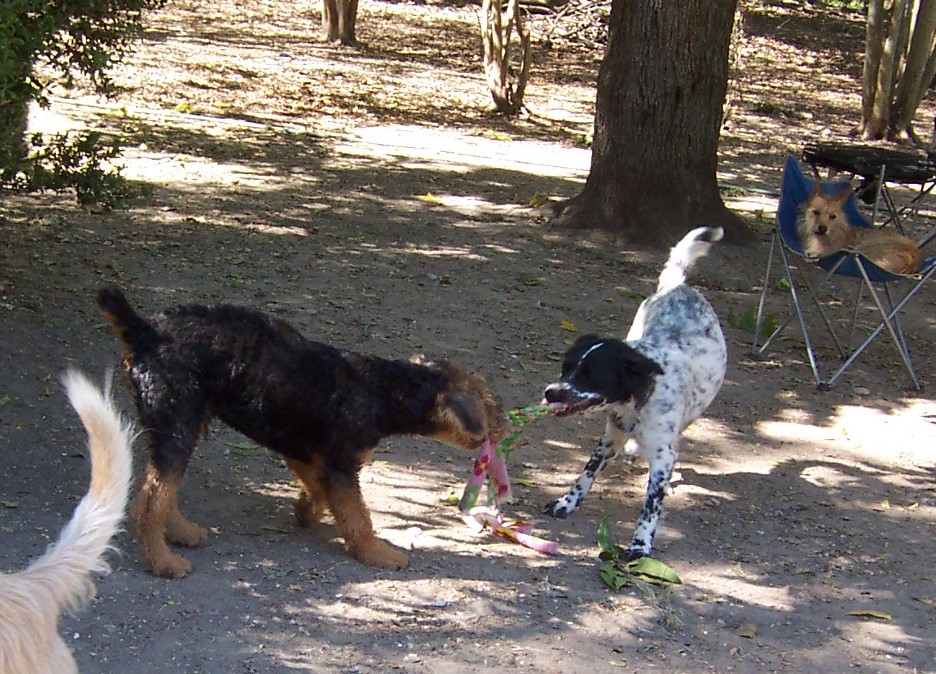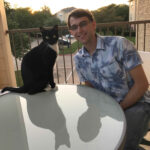
It’s all about the relationships
The most enjoyable multi-dog households are the ones in which there is a rich individual relationship between each human and each dog in the home. Create these relationships through private time with each dog. Pleasant walks, fun training sessions, the dog’s favorite games, quiet time sharing affection, and other pleasant pastimes are key. It’s challenging to maintain each of these one-on-one relationships as more dogs or more people come into the picture.
Every dog is an individual
Each dog has his or her strengths and weaknesses. Just like kids on a playground, some are bossy, some are shy, some just want to have fun, some want all the toys to themselves. Some dogs will sleep anywhere, others want to have one special place. Some like to run around and hunt in the yard, others don’t really even want to go outside. Some are upset when you leave and others are content to spend time alone. Behavior science has shown that we can modify these behaviors. It takes an understanding of dogs.
It’s not a pack; it’s a blended family
Feral dogs out on the street form social structures. Left to their own devices, dogs in your home will do the same. The problem is that feral dogs generally live alone. Their social structure includes separating themselves from other dogs as needed, often making sure another dog stays far away. Your dogs don’t have that option, nor do you want them to. Dogs don’t have the choice of who their housemates are so you have to help them feel safe and secure in the group. You choose the dogs. You have to help them get their needs met. That includes physical, emotional, social, and mental stimulation needs, and remember, each dog’s needs and desires are different. You can’t leave it up to the dogs to work things out; you need to be involved to make sure your own needs for safety, security, and a peaceful household are met.
The role of stress among multiple dogs in a home
Stress takes on many faces. Under the pressure of stressors, some dogs shut down. Others appear “hyperactive.” It’s important to understand the signs and impacts of individual canine stress in any multi-dog household. It may be particularly challenging with rescue dogs who may have been stressed in the situation they were rescued from. Stress may continue to build if you don’t work hard to reverse it.
Sometimes people think other dogs will naturally relieve stress in new dogs brought into the household. Other dogs may help; but if you don’t pay attention, the resident dogs may actually cause a more stressing situation. You must know how to read dogs’ body language to know when they’re relaxed and comfortable. You must be able to understand their symptoms of stress and to notice signs of trouble brewing. Check out Turid Rugaas’ website for an introduction to understanding dog body language. Ask about our Dog Reading Online Course if you want to dive deep into the topic.
Your other dogs are not always helping a new dog de-stress. They may not even be allowing their current canine housemates to de-stress. Take steps to make sure each dog has “enough” physical and emotional space to feel relaxed and comfortable. What is “enough?” It’s different for every dog, which makes things more difficult. Ask the dogs. You have to pay attention to their body language to know for sure.
Everybody needs “alone time”
Set up “alone time” for each of your dogs each day. They need a rest from always being “in a crowd”. As an added benefit, you’ll be building the skills necessary for being comfortable alone. You can help your dogs reduce stress, relax, and learn a useful skill set for being alone, all at once. Dogs can have an opportunity to chew something during this time, giving physical release to stress. They may just want to sleep deeply, not having to worry about another dog walking up on them during their nap. When it’s time to hang out with the group again, all the dogs will be fully refreshed. Stress will be at a minimum and they’ll all be ready to use their best interaction skills.

At this moment, the foster dog is on the right, next to one of the resident dogs. The other resident dog is several feet away.
Teaching multiple dogs to be alone
Some dogs may be uncomfortable left alone at first, but you can build that skill in small steps. Try confining each dog for a short rest period every day. Carefully provide a bit more space between them each time until they are in separate rooms. Of course, each dog should happily anticipate “alone time”. Give each dog a soft bed to relax on and a stuffed Kong or yummy chew that he only gets during this time. Begin with just a short rest time after some stimulating activity and build up to longer periods. General stress reduction in other areas can help reduce the stress of being alone. Consider your daily routine as you make a plan to develop your dogs’ skills at being alone.
Training a group of dogs, starting with just one
In multi-dog households, it’s helpful to train individual dogs first, then start to train a couple of dogs together. Teaching dogs to move away from the front door so they don’t rush the door every time it opens is one example. Put all the dogs away for their rest period except for one and pick out an interior door threshold to begin. Stand on the opposite side of the doorway and toss a treat across the barrier, behind the dog so he turns away to get it. As he approaches the doorway again, toss another treat behind him. Make this a fun training game, keeping the dog behind the line for an entire 2-minute training session. Switch to training at the front door when you see your dog waiting behind the line.
Play the game at an exterior door
Teach dogs to “wait” inside while you go out. “Waiting” outside while you get a towel to wipe a dog’s feet can keep muddy paws off your floors! Start with a doorway that leads to a safely fenced yard.
You can add the verbal cue “Wait” when you can predict the dog will stop at the doorway every time. We will teach you the best ways to add cues to the behaviors you teach your dog in our Basic Manners Class.
Adding another dog to a training game
When you see the dog clearly waiting at the door, you’re ready to add another dog to the game. Toss the treats so one dog goes a little to the left and the other goes a little to the right. Even long-term housemates can become aroused and fight over food, so make sure they don’t go for the same treat. You will be pretty good at directing your throws after training each of your dogs individually! Try a different group of two before adding a third dog. Practicing this behavior will make your household more peaceful and provide some fun, one-on-one time with each of your dogs.
Train each individual dog to look calmly at you while you ring the doorbell or knock. If a particular dog is very sensitive to doorbells, knocking, or people walking up to the door, you’ll need to de-sensitize him to those stimuli and counter-condition him to check in with you and stay behind the line. We teach this skill set in our Basic Manners Class.
Every dog has his or her own path
Walking a group of dogs, training the group in how to behave at the front door or at mealtime takes practice. Making sure everyone can comfortably hang around together takes practice. You need to monitoring playtime to make sure everyone has fun and things don’t get out of hand. If you have a safe place to do so, leash-free walks in the woods with the group are ideal. Every dog will have room to express himself with plenty of space between dogs. Individual relationships with every dog will help you be able to get them all to check in with you regularly.
Multi-dog households bring up human feelings of the need to be fair. While you love your dogs and want to meet all their needs, that may not mean spending the exact same amount of time with each one every day. Connect each treat with a desirable behavior and make sure each dog gets some one-on-one time with you each day. Their needs are different, so focus on each individual to determine what they need most right now. Every dog can offer some behavior you can reward: being quiet when he typically barks, sitting, dropping what he’s doing to come across the room and greet you when you walk in – all deserve the communication, “Hey, I see you went to some trouble to do that, and I appreciate it. You can have a treat. And let’s spend some time together.” That’s what great relationships are built on.

Relationships between dogs in multi-dog households
In multi-dog households, dog-to-dog interactions are secondary to your individual relationships with each of your dogs. Watching dogs play together is fun, and it’s ever so adorable when two of them curl up together to sleep. But you have the power to change the environment when you notice stress signs among your dogs. You must always monitor because behavior never remains the same; it is always growing and changing. You brought them together, and your dogs need you to monitor their physical, emotional, social, and mental stimulation needs. You must pay attention to their subtle, wordless communications to each other and to you.
Things will change, sometimes daily, sometimes as dogs mature and grow old and wise. Two dogs sleeping together today may want to be apart tomorrow, and that’s OK. You need private time to develop yourself as an individual and so do your dogs. Your dogs will tell you what they need; you just have to read their silent communications. Ask us about our online Dog Reading Course to sharpen your skills. Pay attention to the subtleties of playtime and dog interactions around the house and adjust as needed, and peace will reign.

